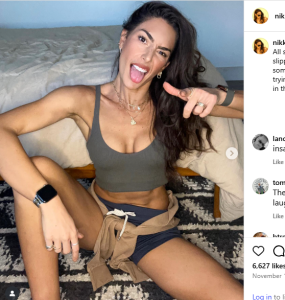Delhi : In recent years, Instagram, the social media giant owned by Meta, has faced mounting criticism over its handling of sexual content, censorship practices, and their implications for users, particularly teenagers. The platform, which boasts over 2 billion active users, has become a battleground for debates about freedom of expression, body positivity, and the protection of vulnerable users from harmful content. As Instagram navigates these complex issues, its policies and algorithmic decisions have raised significant concerns about fairness, transparency, and the unintended exposure of minors to inappropriate material. This article explores the multifaceted problem, highlighting the tensions between artistic expression, censorship, and the platform’s responsibility to safeguard its youngest users.

Instagram’s content moderation policies, particularly around nudity and sexual content, have long been a point of contention. The platform’s Community Guidelines explicitly prohibit most forms of nudity, with exceptions for specific contexts like breastfeeding, childbirth, health-related situations (e.g., post-mastectomy or gender-affirming surgery), or acts of protest. However, these exceptions are inconsistently applied, leading to accusations of arbitrary censorship. For instance, posts by marginalized groups—such as plus-size, dark-skinned, or nonbinary individuals—are disproportionately flagged or removed, even when they comply with guidelines. Sheerah Ravindren, a nonbinary Tamil activist, has spoken out about their posts being removed despite adhering to Instagram’s rules, such as covering nipples to protest eurocentric beauty standards. This selective enforcement has fueled claims that Instagram’s algorithms disproportionately target certain demographics, raising ethical questions about bias in content moderation.
The #FreeTheNipple movement, which advocates for gender equality in the depiction of nudity, has been a vocal critic of Instagram’s policies. In 2020, Instagram updated its nudity guidelines following backlash over the censorship of plus-size Black women, but the changes did little to quell concerns. Meta’s Oversight Board, an independent body funded by the company, has since recommended an overhaul of these policies, arguing that they create “greater barriers to expression” for women, transgender, and nonbinary individuals. The board’s 2023 ruling, which followed the removal of posts by a nonbinary and transgender couple discussing gender-affirming surgery, highlighted the “extensive and confusing” nature of Instagram’s nudity rules, particularly around female nipples. These policies, critics argue, not only stifle artistic and political expression but also reinforce outdated gender norms.

In favor of allowing such content, advocates argue that Instagram’s strict policies suppress body positivity and self-expression. Movements like #FreeTheNipple and projects such as the one documented by PAPER Magazine, which featured contributions from 49 photographers celebrating diverse femme forms, underscore the artistic and cultural value of uncensored depictions of the body. These creators argue that nudity, when presented in a non-sexualized context, can challenge societal norms, promote inclusivity, and empower marginalized groups. By censoring such content, Instagram risks alienating creators who use the platform to advocate for social change, potentially pushing them to alternative platforms with less restrictive policies.
However, the flip side of this debate is equally troubling: Instagram’s failure to adequately protect its youngest users from sexual and violent content. Reports from sources like Mashable and Quartz have revealed that Instagram’s “Teen Accounts,” designed to offer enhanced safety controls for users under 18, are still being inundated with inappropriate material. A limited case study by Accountable Tech found that sexual content easily bypasses these controls, appearing in teens’ feeds through Reels and other algorithmic recommendations. In June 2024, Meta confirmed an issue causing users, including minors, to be flooded with violent and sexual Reels, attributing it to a technical glitch. This incident underscores a broader problem: Instagram’s algorithms, while quick to censor certain types of content, often fail to filter out harmful material that reaches vulnerable audiences.

The exposure of teens to sexual content is particularly alarming given Instagram’s popularity among young users. A 2024 report by Quartz noted that children’s feeds are increasingly filled with suggestive content, raising concerns about the platform’s ability to enforce age-appropriate restrictions. This issue is compounded by Instagram’s algorithmic shift away from chronological feeds, which gives the platform greater control over what users see but also makes it harder to prevent harmful content from surfacing. For parents and advocacy groups, this represents a failure of corporate responsibility, as Meta appears to prioritize engagement over safety.Moreover, Instagram’s censorship practices have been criticized for their lack of transparency. The phenomenon of “shadow banning,” where accounts become less discoverable without notification, has affected creators like those at Unwoke Narrative, who report being unable to appear in search results or losing followers algorithmically. Similarly, pro-Palestinian activists have accused Instagram of stealth censorship through fact-checking controls that reduce the visibility of certain posts. These practices, often justified as efforts to combat misinformation or guideline violations, have led to accusations that Instagram selectively silences voices that challenge dominant narratives.The case of Australian comedian Celeste Barber further illustrates the inconsistency of Instagram’s moderation. Barber, known for parodying celebrity poses, faced repeated content removals, prompting her to call out the platform’s “pathetic” policies. Her experience highlights a broader issue: Instagram’s algorithms often fail to distinguish between satire, art, or activism and content deemed inappropriate, leading to widespread frustration among creators.

The implications of Instagram’s approach to sexuality and censorship are profound. On one hand, overly strict policies stifle free expression and disproportionately affect marginalized groups, undermining the platform’s role as a space for creativity and advocacy. On the other, the failure to protect teens from sexual and violent content raises serious ethical and legal questions about Meta’s priorities. The company’s reliance on algorithms, which lack the nuance to differentiate between harmful and artistic content, exacerbates these issues. While Meta has promised reforms, such as those announced by CEO Mark Zuckerberg to reduce censorship, skepticism remains about whether these changes will address the root problems.

As Instagram continues to shape cultural conversations, its handling of sexuality and censorship will remain a flashpoint. The platform must balance the need to protect users, particularly minors, with the imperative to foster free expression and inclusivity. For now, the tension between these goals has left many users—creators, activists, and teens alike—caught in the crossfire of a flawed system. Meta’s ability to address these concerns transparently and equitably will determine whether Instagram can reclaim its role as a platform for diverse voices or continue to alienate its user base.
Instagram’s struggle with sexuality and content moderation reflects broader challenges in the digital age. The platform’s policies, while intended to create a safe and inclusive environment, often fall short, either by over-censoring legitimate expression or under-protecting vulnerable users. As the debate continues, stakeholders—users, creators, and regulators—must demand greater accountability from Meta to ensure that Instagram serves as a platform for empowerment, not restriction or harm.





